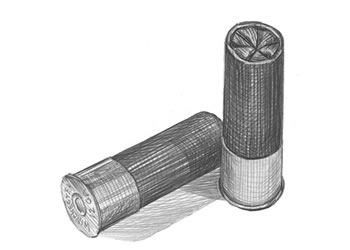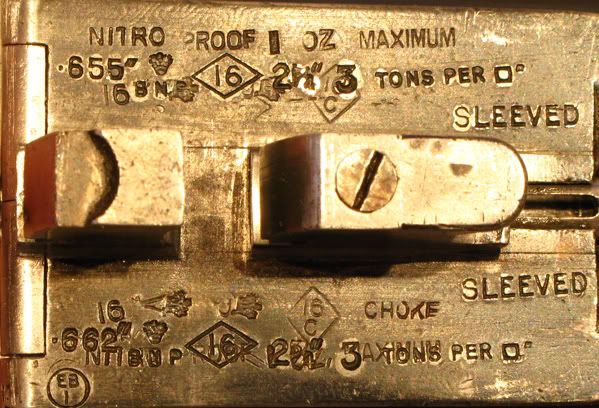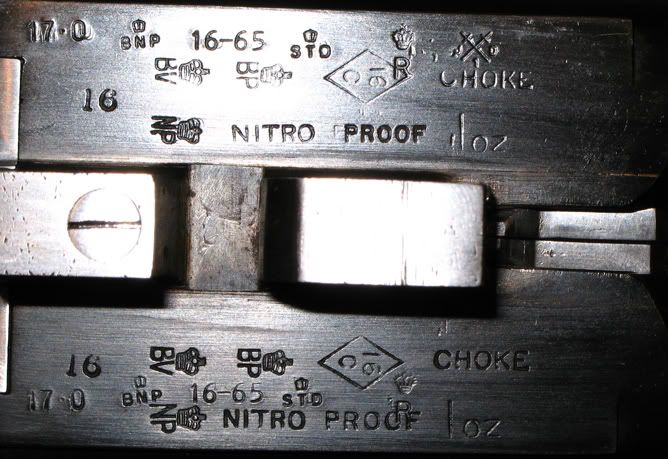

 The Accurate Reloading Forums
The Accurate Reloading Forums  THE ACCURATE RELOADING.COM FORUMS
THE ACCURATE RELOADING.COM FORUMS  Guns, Politics, Gunsmithing & Reloading
Guns, Politics, Gunsmithing & Reloading  Shotshell Reloading
Shotshell Reloading  proof question
proof questionGo  | New  | Find  | Notify  | Tools  | Reply  |  |
| One of Us |
Does a 70 mm nitro proof on a Damascus barreled shotgun mean it is safe with modern 2 3/4" loads? Thanks. Good hunting, Andy ----------------------------- Thomas Jefferson: “To compel a man to furnish funds for the propagation of ideas he disbelieves and abhors is sinful and tyrannical.” | ||
|
| One of Us |
Andy: We need more information, but generally no. From your question, I assume proof of the gun is British. That would mean that it's safe with the modern 2 3/4" BRITISH load marked on the flats (3 tons/850 BAR; 3 1/4 tons/1200 BAR, etc.), NOT with modern 2 3/4" American (SAAMI) loads. | |||
|
| One of Us |
Thanks, 400NE. I'll have to contact the seller and ask for more info. The ad claims it is safe with modern 2.75" loads, but gives no info other than the 70 mm proof. Good hunting, Andy ----------------------------- Thomas Jefferson: “To compel a man to furnish funds for the propagation of ideas he disbelieves and abhors is sinful and tyrannical.” | |||
|
| One of Us |
Well yes, and no. Sorry! Yes in that on the day it was tested it was safe with those loads and that firing them has disclosed no weakness or produced a dimensional change in the gun. It therefore is no more guarantee of future condition than putting Mr Andy ACRecurve on a set of scales, weighing him, and saying that he is going to be that weight tomorrow or next week. Proof says the gun was OK at the time of that SINGLE test. It doesn't guarantee that the gun won't "let go" the very next shot. There are other factors. Wall thickness of the barrels is important. Again Proof will not concern itself at all with that. Thus you may buy a proved gun with barrel walls only 20 thou thick. Drop it and dent the barrels and they may not be enough metal to then make a safe repair of pushing the dent out, hammering it down and then filing it to the same radius as the outsdie of the barrel. But. Having said that as Proof is the firing of an overcharge load then yes, your gun will be safe with modern NITRO loads within the "service pressure" marked on the barrel flats. Here in UK we do not hesitate to use these guns with modern British or European CIP tested smokeless cartridges and have no second thoughts or doubts. This includes imported American cartridges that fall within the same CIP pressure, when tested, as the gun is proved for. However it won't like steel shot and is probably best not shot with tin or tungsten shot either as the barrel won't like them. Or slug! The other issue is not that the barrels will, or won't, stand steel shot but that if the gun has and iron action it won't like the different pressure thrust pattern that such cartridges supposedly generate. | |||
|
| One of Us |
Thanks, ES! If I decide to purchase this gun, I'll likely load the shells for it either with black powder or 7/8 to 1 oz loads at low pressures. Handloading has it's advantages! Lead shot is still legal here for everything except waterfowl...at least in the areas where I hunt. I've asked for the proof load on the barrel flats, but haven't heard back from the request yet. I think a hammer gun loaded with black powder would be great fun to shoot at doves and quail! Good hunting, Andy ----------------------------- Thomas Jefferson: “To compel a man to furnish funds for the propagation of ideas he disbelieves and abhors is sinful and tyrannical.” | |||
|
| One of Us |
The barrel flats have an SP (standard pressure?) with a crown over it. It was proofed last year. Does that tell us anything? Good hunting, Andy ----------------------------- Thomas Jefferson: “To compel a man to furnish funds for the propagation of ideas he disbelieves and abhors is sinful and tyrannical.” | |||
|
| One of Us |
Just got this from the seller:
Good hunting, Andy ----------------------------- Thomas Jefferson: “To compel a man to furnish funds for the propagation of ideas he disbelieves and abhors is sinful and tyrannical.” | |||
|
| One of Us |
Is this gun a 16 bore BTW? Either way it was proved in London. The chambers would have had to be lengthened as I believe that the 2 1/2" 16 GAUGE cartridge is not common in America the usual length being 2 3/4". (Metric equivalent 2 1/2" is 65mm and 2 3/4" is 70mm with 3" being 76mm) Try here: http://www.basc.org.uk/media/100_proof.pdf Here is a link to the Birmingham Proof House - with "pictures" of Birmingham Proof Marks: http://www.gundealersonline.com/firearmid_english.asp Here is what a reproved gun done with imperial (inches and pressure in tons) units BIRMINGHAM "English" marks will look like on the flats. This gun is a 16 GAUGE:  Here is what a reproved gun with metric (millimetres and pressure in BAR) BIRMINGHAM "English" marks will look like on the flats: This gun is a 16 GAUGE: 16-65 means a 2 1/2" length cartridge. 16-70 would mean a 2 3/4" length cartridge. London Proof would have "LP" or a curved scimitar type sword under the royal crown instead of the "BP" or "BNP".  You can see the "STD" and in this case 17.0 (millimetres) which is the internal diameter of the barrel, at approximately 9" from the breech end (or whatever distance the metric rules say) yours at 16.9 (millimetres) being a little tighter. That doesn't mean that this man's Harkom is worn just that some makers bored with a lesser or greater diameter than others. Or that it has been slightly bored out to remove pitting marks. This is used to give a reference of what the internal diameter of the bore (in bottom picture in metric units) was when the gun was measured at time of Proof. On the top picture with the imperial units (inches and tons) that measurement is expressed as .655 (of an inch) and .662 (of an inch). IN BOTH CASES EARLIER PROOF MARKS CAN BE SEEN FROM WHEN EACH GUN WAS MADE AND USING THE MARKS SPECIFIED IN THE RULES OF PROOF IN FORCE AT THAT TIME. WITH MARKS DONE LATER (AT SLEEVING OR REPROOF) UNDER LATER RULES OF PROOF STAMPED "ON TOP" OF THEM. If when the gun is measured that bore diameter has increased over the .655 or on the other barrel .662 then the gun is said to be "out of Proof". This is again a bit of a nonsense as it does not mean that it is unsafe just that the bores have worn a bit wider or that the gun has been bored out to remove pitting that has happened since it was marked with those sizes. In most cases the gun would still be perfectly safe to shoot! Think of it like an engine block on a car having been rebored. The engine is still safe just that it now has a bore of +20 thou as against original maker's specification when it was made. It is not useless and fit only for scrap just slightly larger in internal diameter than when made. If you then however take it to extreme if you lose too much metal from the inside it will reduce the thickness of the barrels at the breech to a point where they may be dangerous as there isn't enough "meat" in the barrels left to contain the pressure of the cartridge. So the marks are for that really. Hope this helps! One GREAT advantage of the old imperial system was it did actually give the maximum normal usage shot weight recommended for the gun! So old British 12 GAUGE 2 1/2" chambered guns would be stamped 1 1/8 ounces and old British 12 GAUGE 2 3/4" chambered guns 1/14 ozs and old British 12 GAUGE 3" guns 1 1/2" ounces. Equivalent (I think but may be wrong) in 16 GAUGE is 2 1/2" was 1 ounce and 2 3/4" was 1 1/18 ounces. 20 GAUGE was 2 1/2" at 7/8 ounces at 2 3/4" at 1 ounce. So in some ways the old marks that showed maximum shell length and also normal service weight of shot charge were easier to understand and interpret! | |||
|
| One of Us |
One more thing...black powder will produce pressure all the way up the barrel. Nitro powder up only half of its length. That is why the old "VIEW" or "PROVISIONAL" Proof used black powder as it was a gunmakers' proof that would show any weakness up the full length of the barrels. So, in one sense, nitro is gentler to older barrels as the pressure at the front end half of the barrel - where it is thinner - is less. | |||
|
| One of Us |
Andy: A few observations.
Crown over STD means standard proof, or 850 BAR. This is the equivalent of the old 3 ton proof, but it represents proof pressure, not max service pressure. "LP" over "08" is the London date code for 2008. the "16.9" mark is the bore size at proof in millimeters (.665") and the 16 in a diamond means that it's a 16 gauge. The chamber length is 2 3/4" (70mm). There should be a reproof mark present - a crown over "R".
Since this gun was reproved in London, maybe. The old marks may not be there. In recent years, London has required removal of the old marks for reproof, a needless, expensive aggravation that's been very unpopular with London gunmakers. I've heard that they've recently stopped enforcing this rule, so it will be interesting to see if they're still there with such a recent reproof.
Well, yes, that's the purpose of proof. It's been shown to be a reliable predictor of the safety of a gun, hence the survival of the proof rules in England for 377 years. CIP requires firing two proof loads in each barrel, not just one. Andy, I'd suggest getting min wall thickness checked before you bite. With damascus barrels, I always suggest getting it checked out by a pro that's familiar with British double guns and damascus. Kirk Merrington in Kerrville, TX is a British barrel maker formerly of Churchill's and is sharp. Easy to load effective low pressure shells. | |||
|
| One of Us |
Thanks, guys! Good hunting, Andy ----------------------------- Thomas Jefferson: “To compel a man to furnish funds for the propagation of ideas he disbelieves and abhors is sinful and tyrannical.” | |||
|
| Powered by Social Strata |
| Please Wait. Your request is being processed... |
|

Visit our on-line store for AR Memorabilia

